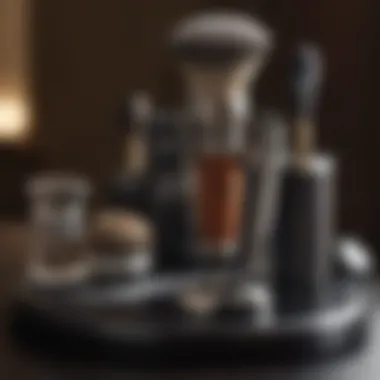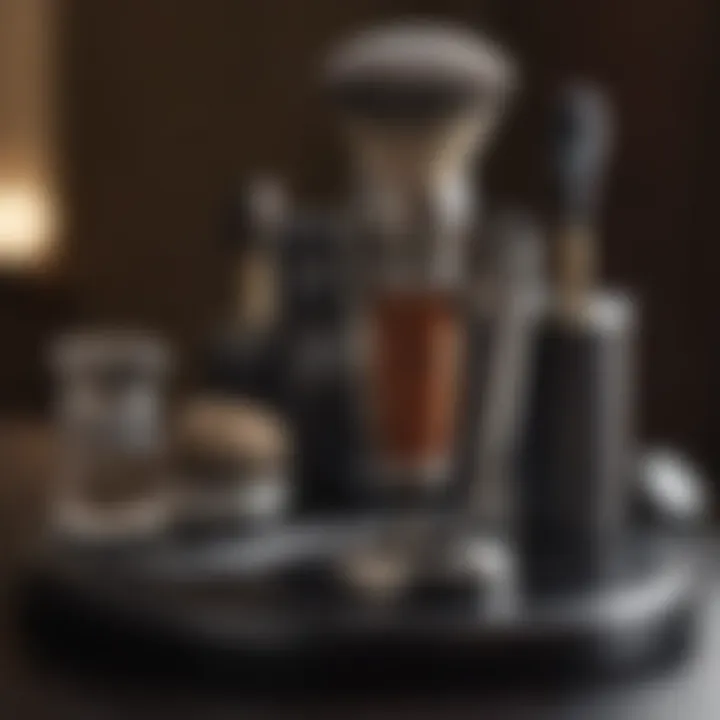Effective Strategies for Treating Razor Bumps


Intro
Preventive Measures
Preventing razor bumps is as crucial as treating them. Taking the right precautionary steps can significantly reduce the chances of developing them in the first place. Consider the following methods:
- Use Sharp Razors: Always opt for fresh, sharp razors to minimize irritation. Dull blades can tug at the skin, increasing the likelihood of cuts and bumps.
- Shave with the Grain: When shaving, always follow the direction of hair growth. Shaving against the grain can cause follicles to become inflamed, leading to razor bumps.
- Exfoliate Regularly: Gentle exfoliation can help remove dead skin cells and prevent hair from becoming trapped under the surface. This can reduce the occurrence of ingrown hairs, which lead to bumps.
Home Remedies
If you do find yourself with razor bumps, various home remedies can offer relief. Here are some notable options:
- Aloe Vera: Known for its calming properties, applying aloe vera gel directly to the affected area can soothe irritation and promote healing.
- Tea Tree Oil: This natural antiseptic can help reduce inflammation. Mix a few drops with a carrier oil and apply it to the bumps.
- Cold Compress: Apply a cold compress to the area to decrease swelling and relieve discomfort.
Professional Treatments
For persistent or severe cases, seeking professional treatments may be necessary. Here are some options to consider:
- Laser Hair Removal: This method can eliminate hair follicles permanently, reducing the chances of developing razor bumps in the future.
- Chemical Peels: These can help exfoliate the skin and promote cell turnover, aiding in the reduction of razor bumps.
- Prescription Creams: Dermatologists can prescribe topical treatments that reduce inflammation or prevent infection.
Post-Shaving Care
What you do after shaving can also impact the formation of razor bumps. Consider these guidelines:
- Moisturize: Use a fragrance-free moisturizer after shaving to keep the skin hydrated and prevent dryness.
- Avoid Fragranced Products: Applying scented lotions or aftershaves can irritate freshly shaven skin, exacerbating razor bumps.
Culmination
In summary, addressing razor bumps requires a multi-faceted approach that includes prevention, immediate care, and professional options. By understanding your skin type and the unique challenges it presents, as well as adopting effective strategies, you can maintain smooth skin while navigating the intricacies of grooming. By following the insights shared in this article, readers will find effective ways to manage and treat this common yet bothersome condition.
Understanding Razor Bumps
Understanding razor bumps is crucial for anyone who shaves, particularly for those who prioritize maintaining a polished appearance. Razor bumps can cause discomfort and negatively affect skin aesthetics. By knowing what causes razor bumps and how to recognize them, individuals can implement strategies to prevent and treat this condition effectively. This knowledge becomes especially beneficial for style-conscious individuals, as it helps to manage grooming routines and avoid hindrances to their look.
What are Razor Bumps?
Razor bumps, medically known as pseudofolliculitis barbae, occur when hair curls back into the skin after shaving. These bumps can appear red, inflamed, and may resemble acne. They are often itchy and tender, leading to discomfort. Razor bumps can be more prevalent in individuals with curly or coarse hair, as the hair's shape makes it more likely to revert to the skin and cause irritation. Recognizing this condition is essential for those seeking smooth skin without irritation.
Causes of Razor Bumps
The primary causes of razor bumps include:
- Improper shaving techniques: Shaving against the direction of hair growth increases the likelihood of hair curling back into the follicle.
- Dull blades: Using an old or dull razor blade makes it difficult to achieve a clean shave. This can lead to tugging at the hair, encouraging it to grow inward.
- Sensitive skin: Certain skin types may react more adversely to shaving, leading to increased inflammation.
- Product choices: Harsh shaving creams or aftershaves can irritate the skin, worsening the condition.
Being aware of these causes can help individuals adjust their shaving routines accordingly.
Identifying Symptoms
Identifying the symptoms of razor bumps is essential for proper treatment. Common indicators include:
- Red, inflamed patches: These areas may be warm to the touch and can often be mistaken for acne.
- Itching or burning: Many individuals experience discomfort around the affected area, which can be quite bothersome.
- Visible hair trapped under the skin: Sometimes, the hair can become noticeable under the skin, often requiring special attention for removal.
- Ingrown hairs: These may accompany razor bumps, leading to further irritation.
Recognizing these symptoms early can lead to more effective management of razor bumps, preventing them from becoming a more significant issue.
Preventive Measures
Preventive measures are essential to minimize the occurrence of razor bumps, which can be both unsightly and uncomfortable. This section underscores the importance of taking proactive steps before shaving begins. By establishing a solid routine around shaving, individuals can significantly reduce the chances of developing these irritations. Proper prevention can lead to smoother skin and enhance overall grooming confidence.
Choosing the Right Razor
Selecting an appropriate razor is a critical factor in preventing razor bumps. The razor should match the individual's skin type and hair texture. For sensitive skin, it is often better to choose a razor with fewer blades, as multiple blades can tug the hair and increase irritation. A single or double-blade razor is a good alternative. It is also crucial to ensure that the razor is sharp. Dull blades can cause more friction and contribute to skin irritation. Hence, changing the blades regularly is advisable.
Considerations for selecting a razor:
- Blade type: Single, double, or multi-blade.
- Skin sensitivity: Choose accordingly.
- Razor brand: Some brands are designed specifically for sensitive skin.
Shaving Creams and Gels
The choice of shaving cream or gel is paramount in maintaining skin health. A quality product can create a barrier that protects the skin during shaving. Look for alcohol-free formulas. These tend to be gentler and can reduce irritation. Products containing soothing ingredients such as aloe vera or glycerin can improve the shaving experience by keeping the skin hydrated.
When applying the shaving cream or gel, a liberal amount should be used. This ensures that the razor glides over the skin smoothly, reducing the chances of nicks and cuts. It is also advisable to let the cream sit on the skin for several minutes. This allows it to soften the hair, making them easier to cut, thus providing a closer shave without compromising skin safety.


Shaving Techniques
Employing the correct shaving techniques can have a considerable impact on minimizing razor bumps. First, it is important to shave in the direction of hair growth. Shaving against the hair growth can cause hairs to become ingrown, leading to bumps.
Secondly, it is paramount to use gentle strokes. Pressing the razor too hard can increase irritation. Instead, allowing the weight of the razor to do the work is a better approach.
Key shaving techniques include:
- Prepare skin properly: Hydrate and soften the hair.
- Use short strokes: Avoid long, sweeping motions.
- Rinse the blade often: This can help in preventing clogging and enhance efficiency.
"Proper preparation and technique can greatly reduce the incidence of razor bumps."
Home Remedies for Razor Bumps
Home remedies for razor bumps are an essential part of this discussion, offering affordable and accessible solutions for those affected. Many individuals prefer to explore natural alternatives before considering more extreme treatments. These remedies can soothe irritated skin, reduce inflammation, and speed up the healing process. Importantly, home remedies often have fewer side effects compared to chemical treatments and may be suitable for various skin types.
Incorporating these strategies into a grooming routine can yield effective and gratifying results, promoting smoother skin and a more polished appearance overall.
Cold Compress
The use of a cold compress is one of the simplest and most effective home remedies for razor bumps. Applying a cold compress reduces swelling and alleviates discomfort. The cool temperature constricts blood vessels, which can minimize irritation.
To create your own cold compress, wrap several ice cubes in a clean cloth. Apply this for about 10-15 minutes on the affected area. This method is especially useful post-shave when the skin is particularly sensitive.
Regular use can help in preventing future outbreaks of razor bumps, contributing to overall skin health.
Aloe Vera Application
Aloe vera is renowned for its soothing properties and is a go-to remedy for those dealing with razor bumps. The gel extracted from this plant helps to hydrate the skin while reducing inflammation caused by shaving. The anti-inflammatory compounds in aloe vera can provide relief and help calm the skin.
For best results, apply fresh aloe vera gel directly onto the affected area. Leave it on for about half an hour before rinsing it off. Incorporating aloe vera in your post-shave routine can enhance your skin's texture and may even aid in healing minor cuts or nicks incurred during shaving.
Tea Tree Oil Treatment
Tea tree oil is another excellent home remedy suitable for treating razor bumps. This essential oil possesses antiseptic and anti-inflammatory properties, making it effective in reducing redness and preventing infections. When diluted, it can be used safely on the skin.
To use tea tree oil, mix a few drops with a carrier oil, such as coconut or olive oil, to dilute its potency. Then, gently apply the mixture to the affected area. This helps in soothing irritation and reducing the risk of future bumps. Keep in mind that a patch test is advisable to ensure no allergic reaction occurs.
"Natural remedies can be an effective first step in managing razor bumps, providing results without harsh ingredients."
Utilizing home remedies can significantly improve the skin's condition following shaving. These methods are often cost-effective and can be included in everyday grooming practices.
In summary, these home remedies—cold compress, aloe vera, and tea tree oil—can effectively alleviate symptoms of razor bumps. Regular application combined with proper shaving techniques can help individuals enjoy smoother skin and minimize the discomfort associated with razor bumps.
Chemical Treatments
Chemical treatments play a vital role in addressing razor bumps effectively. They work by targeting the underlying causes of irritation and inflammation, making them essential for both treatment and prevention. These treatments can help exfoliate the skin, reduce redness, and prevent ingrown hairs, all of which are key factors in the development of razor bumps. However, consideration is necessary when choosing these products, ensuring they are suitable for your skin type to avoid further irritation.
Exfoliating Products
Exfoliating products are crucial in the fight against razor bumps. They contain ingredients that remove dead skin cells, helping to prevent clogged pores which can lead to bumps. Common exfoliating ingredients include alpha hydroxy acids (AHAs) and beta hydroxy acids (BHAs). These compounds not only smooth out the skin's surface but also promote cell turnover, making skin healthier overall.
When selecting an exfoliator, it is important to consider your skin type. For sensitive skin, gentler formulations with lower concentrations of active ingredients are preferable. It's advisable to integrate exfoliation into your routine gradually, perhaps starting once a week, and then increasing frequency as the skin adjusts.
Hydrocortisone Cream
Hydrocortisone cream can be effective for reducing inflammation associated with razor bumps. This topical steroid works by suppressing the immune response, which can decrease redness and itching. However, it is crucial to use this cream as directed. Prolonged use can thin the skin, making it more susceptible to injury and irritation.
When applying hydrocortisone, use a thin layer directly on the affected areas after shaving. Limit use to a few days during flare-ups and consult with a dermatologist if you find yourself needing it frequently.
Salicylic Acid Solutions
Salicylic acid is another potent option for treating razor bumps. As a BHA, it penetrates deep into the pores, effectively exfoliating the inside and helping to prevent ingrown hairs. Salicylic acid solutions can be found in various formulations, from cleansers to spot treatments.
For those seeking to incorporate salicylic acid into their routine, starting with a lower concentration is recommended, particularly for sensitive skin. Regular use can lead to clearer skin and fewer bumps over time. Always follow up with a moisturizer, as salicylic acid can be drying.
Professional Treatment Options
Professional treatment options can be crucial for individuals who suffer from persistent razor bumps. While preventive measures and home remedies can provide relief, sometimes these methods are not sufficient. Consulting with experts in the field ensures that one gets tailored solutions that address the underlying causes of razor bumps. Understanding these options not only empowers individuals but also equips them with tools to manage their skin health more effectively. The benefits of professional treatments include specialized knowledge, targeted solutions, and access to advanced technology that may not be available over the counter.
Consulting a Dermatologist
Visiting a dermatologist is a significant first step for anyone facing ongoing issues with razor bumps. These skin experts can diagnose the severity of the condition and rule out other issues such as infections or allergic reactions. A dermatologist will typically perform a thorough examination and ask about any previous treatments tried. Based on this information, they can recommend personalized treatment plans that could include medications, topical treatments, or changes to shaving techniques.
"A dermatologist can provide insights that are often overlooked in DIY treatments."
This specialized care enables individuals to understand their skin better and the unique factors contributing to razor bumps. Furthermore, dermatologists often suggest methods specific to a person’s skin type, whether it is oily, dry, or sensitive. Incorporating professional insights can often lead to more effective management approaches.
Laser Hair Removal


Laser hair removal is an increasingly popular option for those looking to eliminate razor bumps altogether. Unlike traditional shaving, this method targets hair follicles directly and reduces the chances of ingrown hairs. The treatment involves multiple sessions and can be tailored to fit various skin and hair types.
The benefits of laser hair removal include:
- Long-Term Solution: Over time, hair growth diminishes significantly, offering a permanent solution for many.
- Reduced Risk of Bumps: By preventing hair from growing back in a way that causes irritation, this method minimizes the chance of developing new razor bumps.
- Minimal Downtime: Most patients can return to regular activities shortly after treatment, assuming they follow post-care advice.
While the initial investment can be high, the long-term savings and skin benefits often make laser hair removal a worthwhile consideration for those focused on maintaining smooth skin.
Chemical Peels
Chemical peels present another professional option that can help alleviate the symptoms associated with razor bumps. This treatment involves applying a chemical solution to the skin, which exfoliates the outer layers.
There are three primary types of chemical peels:
- Superficial Peels: These use mild acids to gently exfoliate, suitable for light issues stemming from razor bumps.
- Medium Peels: Utilizing stronger acids, these can address deeper skin issues and improve overall skin texture.
- Deep Peels: These are more intensive treatments that remove deeper layers of skin, often performed under medical supervision.
The choice of peel should be discussed with the dermatologist to align with individual skin needs. After treatment, patients might experience some redness and peeling, but these symptoms generally subside quickly. The ultimate goal of chemical peeling is not just to alleviate razor bumps but also to promote healthier skin and prevent future occurrences.
Post-Shaving Care
Post-shaving care is a crucial part of maintaining skin health and ensuring a smooth finish after grooming. After shaving, the skin can become irritated and prone to challenges like razor bumps. Proper care not only soothes the skin but also minimizes complications. It is essential to adopt strategies that protect and nourish the skin in the aftermath of shaving.
Moisturizing Techniques
Moisturizing is a fundamental post-shaving technique that helps restore hydration to the skin. When shaving, the protective oils on the skin can be stripped away. Applying a quality moisturizer can help combat dryness and reduce irritation. Look for moisturizers with ingredients like aloe vera or vitamin E, as these can replenish the moisture barrier. Using an unscented product can also minimize the risk of allergic reactions or additional irritation.
Moreover, applying moisturizer immediately after shaving can lock in hydration, making the skin feel softer. This simple step can lead to long-term benefits, including a healthier skin appearance and fewer razor bumps. If you have sensitive skin, opt for a lightweight, non-comedogenic moisturizer to prevent blocking pores.
Avoiding Irritants
Irritations can lead to severe discomfort and aggravate the skin after shaving. To mitigate this, avoiding potential irritants is vital. Common irritants include alcohol-based aftershaves, fragrances, and heavy creams. It is advisable to select products specifically designed for post-shaving care that contain soothing agents. Ingredients such as chamomile or witch hazel can provide cooling and calming effects.
In your daily routine, be mindful of other potential irritants, such as harsh soaps or exfoliating scrubs. Choosing gentle cleansers promotes skin recovery. Keep in mind that it is a good practice to allow your skin to breathe by not overloading it with products right after shaving.
Regular Skin Assessment
Regular skin assessment plays an integral role in effective post-shaving care. By observing how your skin responds to shaving and post-shaving products, you can make informed adjustments to your routine. Look for patterns such as redness, swelling, or the formation of bumps. Keeping a written record can help identify triggers and effective strategies for your skin.
Additionally, understanding individual skin types helps in selecting the right products and techniques. For instance, oily skin may benefit from lighter, oil-free formulations, while dry skin may require richer, hydrating creams. It is advisable to consult with a dermatologist if you notice persistent issues. Regular monitoring not only helps maintain skin health but fosters greater awareness of personal skincare needs.
Maintaining proper post-shaving care can significantly reduce the occurrence of razor bumps and enhance overall skin health.
Lifestyle Adjustments
Lifestyle adjustments play a significant role in managing and preventing razor bumps. These changes can influence overall skin health and, by extension, how the skin reacts to shaving. The daily decisions we make regarding our diet, hydration, and stress levels will ultimately reflect on our skin. Conducting thorough research about the interconnections between these factors makes clear the influential nature of lifestyle choices on skin conditions.
Eating a Balanced Diet
A balanced diet is essential for skin health. Consuming a variety of nutrients helps in maintaining the skin's integrity. Foods rich in vitamins A, C, and E, alongside Omega-3 fatty acids, can promote healthy skin and mitigate irritation after shaving.
- Vitamin A can be found in carrots, sweet potatoes, and spinach. It encourages cell turnover, which may help to prevent clogged pores.
- Vitamin C is crucial for collagen production. Sources include citrus fruits, strawberries, and bell peppers. Adequate collagen supports the skin's structure.
- Vitamin E is known for its antioxidant properties and can be found in nuts, seeds, and green leafy vegetables.
- Omega-3 fatty acids, present in fish like salmon and flaxseeds, help reduce inflammation. Lower inflammation can lead to fewer irritation and bumps post-shaving.
Incorporating these elements into one's daily meals ensures that the skin receives the necessary support for resilience against external factors.
Staying Hydrated
Hydration is critical for maintaining skin elasticity and preventing dryness. Drinking enough water daily contributes to skin's suppleness, making it less prone to irritation. It is often suggested that one should aim for about eight glasses of water per day, although individual needs may vary based on activity levels and environmental conditions.
Proper hydration helps in flushing out toxins and keeping skin cells functioning optimally. When the body is well-hydrated, it can better handle the effects of shaving, reducing the chances of razor bumps. Introducing hydrating foods like cucumbers, oranges, and melons can further enhance water intake throughout the day.
Managing Stress Levels
Stress can negatively impact skin health, triggering inflammatory responses that may worsen razor bumps. Techniques for managing stress can be beneficial, including regular exercise, meditation, and adequate sleep. Engaging in physical activity releases endorphins, promoting relaxation and reducing feelings of tension. Meanwhile, practices such as yoga or guided meditation can provide mental clarity and calmness.
Sleep is also essential; lack of proper rest affects the body's recovery processes, thereby influencing skin conditions. Aiming for seven to nine hours of sleep per night can improve overall health and subsequently help manage skin issues.
It is essential to recognize the interconnected nature of lifestyle choices and skin health. Adjustments in diet, hydration, and stress management can significantly influence the skin's response to grooming habits.
Common Myths Debunked
Shaving Does Not Cause More Hair Growth


One prevalent myth is that shaving causes hair to grow back thicker or darker. This notion likely stems from the fact that when hair is shaved, it is cut at a blunt angle. Consequently, it may feel coarser as it begins to grow back, leading some to believe it has changed in density or thickness. However, scientific studies have continuously shown that shaving does not influence the rate of hair growth or its characteristics.
It's important to recognize this myth so individuals do not shy away from shaving due to unfounded fears. Encouraging proper shaving techniques and aftercare is far more beneficial for maintaining skin health rather than worrying about hair growth changes.
Cold Water Does Not Prevent Bumps
Another common misconception is that rinsing with cold water can prevent razor bumps. While it is true that cold water can temporarily soothe the skin and help reduce swelling, it does not prevent the formation of bumps. Razor bumps are primarily caused by ingrown hairs that occur when hair follicles become blocked after shaving.
To effectively minimize the risk of razor bumps, the focus should be on pre-shaving preparation and post-shaving care, rather than relying solely on cold water. This includes using the right shaving cream and a proper technique to ensure a smoother shave, thereby reducing the likelihood of irritation and blockage.
All Razors are the Same
The belief that all razors perform the same is a significant misconception. In reality, razors come in various types, and their design greatly influences the quality of the shave. For example, safety razors, straight razors, and cartridge razors each have distinct features suitable for different skin and hair types.
Choosing the correct type of razor can significantly impact the occurrence of razor bumps. Using a dull blade or a poor-quality razor increases the likelihood of irritation, leading to bumps. Therefore, it is crucial to select a razor that fits individual skin needs and to replace blades regularly.
"Understanding the myths surrounding razor bumps can empower individuals to make informed grooming choices."
When to Seek Help
Understanding when to seek help for razor bumps is crucial for effective management and long-term skin health. Although many individuals can treat mild razor bumps at home, it is important to recognize the signs that indicate a more serious issue. Ignoring these signs can lead to further complications, prolonged discomfort, and even permanent skin damage. Consulting a healthcare professional can provide tailored advice that addresses the underlying causes of razor bumps and ensures proper treatment.
Signs of Infection
Infection can manifest in various ways. You should be vigilant if you notice any of these symptoms:
- Increased Redness: If the area surrounding the razor bumps becomes increasingly red, this may indicate infection.
- Pus or Discharge: The presence of pus is a clear sign that you should seek medical advice.
- Swelling: If the bumps grow larger and become more tender, it's likely that an infection is developing.
- Fever: A systemic response, such as fever, along with razor bumps requires immediate medical attention.
Recognizing these signs early on can save you from further issues and complications, allowing for a faster recovery and less discomfort.
Persistent Irritation
Sometimes, irritation caused by razor bumps may not subside despite using proper shaving techniques or home remedies. If irritation lasts more than a few days and continues to affect your daily activities or comfort, it may be time to consult a dermatologist.
Persistent irritation can indicate:
- Allergic Reaction: You may be allergic to a shaving product or method.
- Infection Development: Initial mild irritation can escalate if not treated properly, leading to more severe issues.
- Underlying Skin Conditions: Conditions such as folliculitis or eczema may require specialized care.
Consulting a professional can help identify the root cause and tailor a treatment plan to address these issues effectively.
Difficulty in Managing Symptoms
If you find yourself struggling with self-treatment methods, or if home remedies fail to deliver the results you expected, seeking professional help is advisable. Difficulty in managing symptoms might signal that the condition exceeds typical razor bumps. Here are some considerations:
- Worsening Situation: If the condition worsens despite your efforts, it’s a sign that more aggressive treatment might be necessary.
- Product Allergy: If you suspect that a product is causing more harm than good, you need to determine the cause.
- Lack of Knowledge: If you feel overwhelmed by the options available or unsure how to treat your skin safely, a professional can guide you.
Overall, recognizing when to seek help is an essential step toward maintaining the health and appearance of your skin. By acting promptly, you can prevent complications and promote healing.
Final Thoughts
Summary of Effective Approaches
Multiple effective approaches can assist in treating and preventing razor bumps. First, preventive measures like selecting the right razor or using appropriate shaving products can significantly lessen the occurrence of bumps. Second, home remedies, such as applying aloe vera or tea tree oil, can provide soothing relief. Finally, if the bumps persist, seeking professional interventions like consulting a dermatologist or considering laser hair removal can be highly beneficial.
Key takeaways include:
- Choosing the correct tools for shaving
- Maintaining a proper skincare routine post-shave
- Utilizing home remedies when bumps arise
- Consulting professionals when symptoms persist
Emphasizing Self-Care
Self-care plays an essential role in managing razor bumps. It extends beyond the immediate act of shaving to a broader understanding of skin health. A regimen reinforcing skin hydration, regular exfoliation, and mindful shaving practices can help mitigate the chances of developing razor bumps.
Furthermore, developing a consistent routine that incorporates the use of soothing products directly after shaving is vital. For instance, moisturizing with non-irritating creams can create a barrier that protects the skin, reducing the likelihood of ingrown hairs.
Tips for effective self-care include:
- Use fragrance-free moisturizers
- Incorporate exfoliating treatments into your routine
- Pay attention to signs of irritation and adjust the regimen accordingly
Continued Education on Grooming
Knowledge is a powerful tool in the battle against razor bumps. Staying educated on the best grooming practices can help individuals navigate the complexities of shaving techniques and products. Regularly updating one's knowledge about new treatments and trends in skincare could greatly improve results.
Engaging with reliable resources such as dermatological studies, expert articles, or forums can provide valuable insights. Not only does this ongoing education empower individuals to make informed decisions, but it also fosters a deeper appreciation for personal grooming and skin health.
Suggestions for ongoing education include:
- Reading articles from reputable skincare sources
- Participating in forums like Reddit for community advice
- Following skincare professionals on platforms like Facebook
"Investing time in understanding your skin's needs can lead to a significant reduction in shave-related issues."















